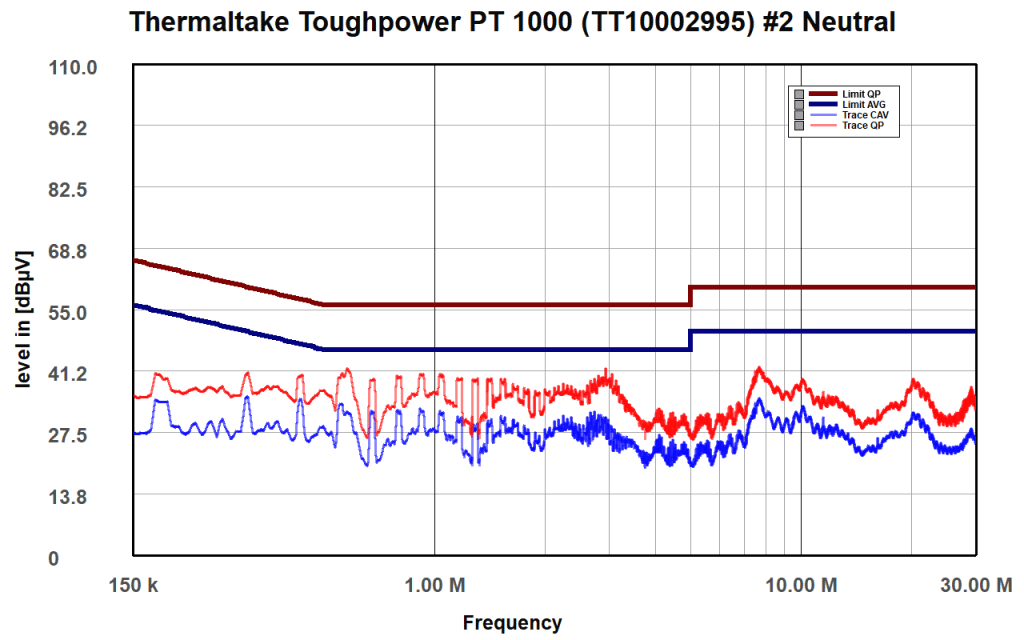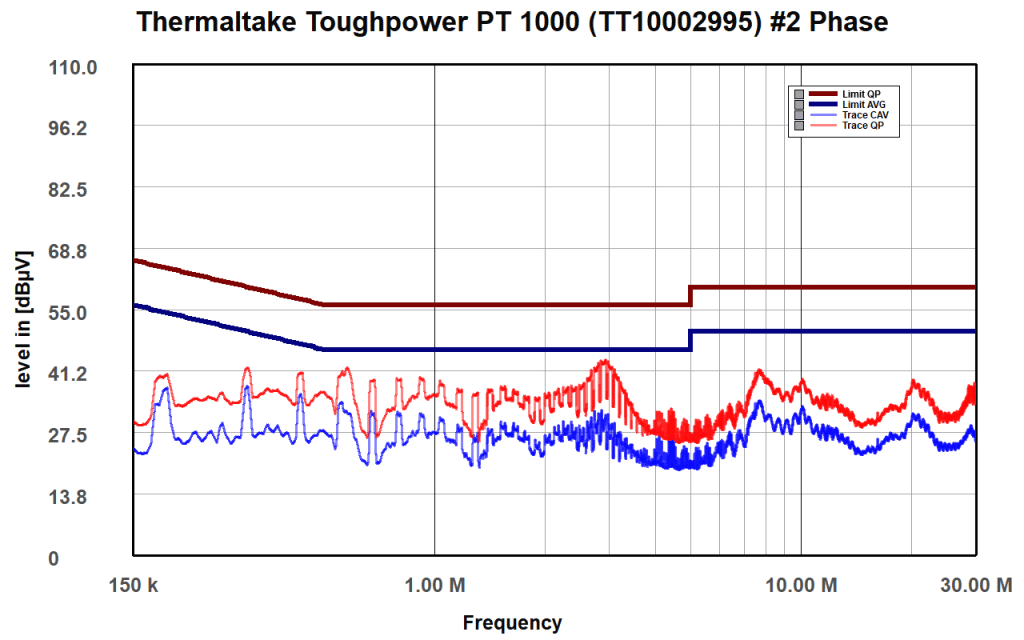Protection Features
Desktop power supply units (PSUs) include several protection features to safeguard both the PSU itself and the connected PC components (motherboard, CPU, GPU, drives, etc.). These protections prevent damage from electrical faults, overloads, or abnormal conditions.
| OCP (Normal @ 29.8°C) | 12V: 97.40A (116.93%), 12.017V 5V: 22.9A (114.50%), 5.033V 3.3V: 24.1A (120.50%), 3.365V 5VSB: 4.6A (153.33%), 4.941V |
| OCP (Hot @ 42.3°C) | 12V: 91.00A (109.24%), 12.031V 5V: 22.7A (113.50%), 5.041V 3.3V: 24A (120.00%), 3.373V 5VSB: 4.5A (150.00%), 4.934V |
| OPP (Normal @ 26.6°C) | 1173.13W (117.31%) |
| OPP (Hot @ 43.4°C) | 1136.07W (113.61%) |
| OTP | ✓ (140°C @ Heat Sink) |
| SCP | 12V to Earth: ✓ 5V to Earth: ✓ 3.3V to Earth: ✓ 5VSB to Earth: ✓ -12V to Earth: ✓ |
| PWR_OK | Proper Operation |
| UVP (Full Load @ 90V) | ✓ |
| UVP (No Damage @ 80V) | ✓ |
| Conducted Emissions EN55032 & CISPR 32 | ✓ |
| NLO | ✓ |
| Fan Failure Protection | ✗ |
| SIP | Surge: MOV Inrush: NTC & Bypass Relay |
Similar to the 1200W model, the OCP and OPP triggering points are correctly set on all rails. The OCP triggering point differences on this PSU’s minor rails are low between normal and high temperatures, but they are highly conservative, so I don’t mind the slight differences. The remaining essential protection features are present and function well, except for fan failure protection, which is not implemented. Manufacturers must quickly realize that fan failure protection is crucial and begin implementing it in their designs.
EMC Pre-Compliance at a Glance
Every electronic device, including PSUs, can be an EMI source, and the amount of EMI it emits can affect the proper operation of nearby devices. EMI can, in some extreme cases, even render them unusable. Some standards have been established to minimize electromagnetic interference (EMI) noise. The corresponding standards for IT (Information Technology) products are CISPR 32 and its derivative, EN 55032, which applies to products sold in the EU. In the EU, every product bearing the “CE” marking must comply with the EN 55032 standard. CISPR 32 and EN 55032 standards categorize devices into two classes: A and B. Class B equipment is intended for domestic environments. Hence, its permitted EMI emissions are significantly lower than those of A-class devices.
Our equipment for EMI readings:
- TBMR-110M EMI-Analyzer DC-110 MHz
- Tekbox TBLC08 LISN
- Tekbox TBFL1 transient limiter
- Tekbox EMCview software
| CISPR 32 / EN55032 Limits | ||
| CISRP 32 / EN 55032 Class A Conducted EMI Limit | ||
| Frequency of Emission (MHz) | Conducted Limit (dBuV) | |
| Quasi-peak | Average | |
| 0.15 – 0.50 | 79 | 66 |
| 0.50 – 30.0 | 73 | 60 |
| CISPR 32 / EN 55032 Class B Conducted EMI Limit | ||
| Frequency of Emission (MHz) | Conducted Limit (dBuV) | |
| Quasi-peak | Average | |
| 0.15 – 0.50 | 66 – 56 | 56 – 46 |
| 0.50 – 5.00 | 56 | 46 |
| 5.00 – 30.00 | 60 | 50 |
| CISRP 32 / EN 55032 Class A 10-Meter Radiated EMI Limit | ||
| Frequency of Emission (MHz) | Field Strength Limit (dBuV/m) | |
| 30 – 88 | 39 | |
| 88 – 216 | 43.5 | |
| 216 – 960 | 46.5 | |
| > 960 | 49.5 | |
| CISRP 32 / EN 55032 Class B 3-Meter Radiated EMI Limit | ||
| Frequency of Emission (MHz) | Field Strength Limit (dBuV/m) | |
| 30 – 88 | 40 | |
| 88 – 216 | 43.5 | |
| 216 – 960 | 46.0 | |
| > 960 | 54.0 | |
Please note that the ATX spec allows a 4 dB margin for conducted and radiated emissions. This means that if a PSU exceeds the limits but stays within the 4 dB margin, it meets the corresponding ATX spec requirement (8.1 Emissions).
EMI Results
The PSU’s EMI emissions are under control.





Here cybenetics reports
850w which is not very good
https://www.cybenetics.com/evaluations/psus/2580/
1000w Malfunctioning protections that don’t engage in time before the minor rails experience a huge voltage drop out of spec.
https://www.cybenetics.com/evaluations/psus/2575/
Basically i wouldnt do none of these
Any chance for review Thermaltake SFX ATX 3.1 ?
If we have it in our database sure.